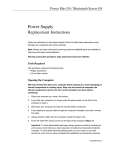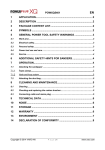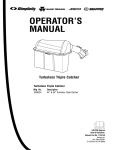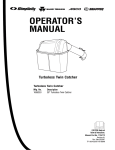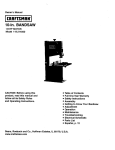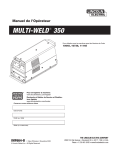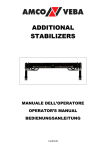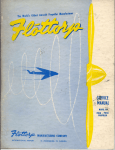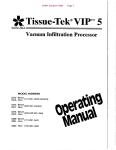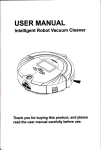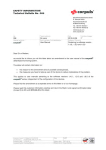Download USER MANUAL Oscillating edge belt sander KOS 2740
Transcript
USER MANUAL Oscillating edge belt sander Read and take care of the operation manual and the safety instructions! Technical changes as well as literal and sentence mistakes reserved! KOS 2740 Ausgabe: 2011 – Revision 2. How to change the sanding belt Open the platen cover (C) by loosing the two bolts on the top of the platen cover. Rise up the handle bar (0) for releasing the sanding belt (E). Next, take off the sanding belt and change a new one then put it back by pushing back the handle bar (0) for tighten up the sanding belt. c-----\-- 9 3. When the sanding belt is not running at the central position of the platen. How to do the micron adjustment for sanding belt alignment adjustment? 5tep 1: Loosen nut (F) 5tep 2: Rotate nut (G) clockwise or counter clockwise to adjust belt tracking. Step 3: When belt is tracking properly. Retighten nut (F) again. G 10 4. How to do the vertical and horizontal sanding Step 1: First loose the two knobs (A) & (8) under the main table and pul! the table backward position. Step 2: Loosen the adjusting knob (H) at the scale and set up the angle as your request by moving the platen (I). Lock the adjust knob (H) again while the angle is set up already. Step 3: Moving the main table forward to close to the platen and tighten up the two knobs (A) & (8) again for insure the table stability. 8----"4.l 11 5. When doing the curve sandin9L.Please do the following steps as below: Step 1: Open the platen cover (J), and fasten it at the c1amp position. Step 2: Loosen the three socket screws. Take the idler roller cover (K) off and mount the sanding drum spindie (L) by tighten 3 pieces of M5 x 15L soc. screw. Step 3: Insert the rubber drum (M) by using one piece of washer and one piece of 1/4" x 1/2" hex. head. screw. Then you can start to do the curving sander. J M----+.. . . L K 12 6. Mounting the dust port before operating.;. Mounting the dust port by using tour pieces ot 1/4" x 1/4" round head screw tightly. Please see below instruction. 13 CONNECTION MACHINE TO POWER SOURCE POWER CONNECTION Aseparate electrical circuit should be used for your tools. This circuit should not be less than and should be protected with a 10 amp, time lag fuse. Have a certified electrician repair or replace damaged or worn cord immediately. Before connecting the motor to the power line. make certain the switch is in the "OFF" position and be sure that the electric current is of the same characteristics as stamped on the motor nameplate. All line connections should make good contact. Running on low voltage will damaged the motor. WARNING : 00 NOT EXPOSE THE DUST COLLECTOR TO RAIN OR OPERATE THE MACHINE IN DAMP LOCATIONS. GROUNDING INSTRUCTIONS WARNING : THIS TOOl MUST BE GROUNDED WHllE IN USE TO PROTECT THE OPERATROR FROM ELECTRIC SHOCK. This belt sander must be grounded. If it should malfunction or break down, grounding provides a path of least resistance for electric current to reduce the risk of electric shock. This belt sander is equipped with a cord having an equipment-grounding conductor and grounding plug. The plug must be inserted into an appropriate outlet that is properly installed and grounded in accordance with alilocal codes and ordinances. WARN ING : Improper connection ofthe equipment-grounding conductor can result in a risk of electric shock. Check with a qualified electrician or service person if you are in doubt as to whether the outlet is properly grounded. 00 not modify the plug provided with the belt sander. If it will not fit the outlet, have a proper outlet installer by a qualified electrician. 14 TROUBLE SHOOTING ~ Turn switch ·OFF" and always remove plug trom power source betore trouble shooting. PROBLEM Motor will not run. PROBABLE CAUSE REMEDY 1. Detective or broken ·ON-OFF" switch. 2. Detective or damaged switch cord. 3. Defective or damaged switch relay. 1-3. Replace all broken or defective parts before using sander. 4. Burned out motor. 4. Consult your local Authorized Service Station. Any attempt to repair this motor may create a hazard unless repair is done by a qualified technician. 5. Blown hause tuse. Machine slows down while sanding. Sanding belt runs off pulleys. Wood bums while sanding. 1. Operator applying too much pressure to workpiece. 1. Use less press ure in applying workpiece to sanding surface. 1. Not tracking properly. 1. Adjust tracking. See "Replacing the Sanding Belt, Tensioning and Tracking, 1. Sanding disc or belt glazed with sap. 2. Excessive pressure being applied to workpiece. 1. Replace belt or disco 2. Aeduce pressure applied to workpiece. ORDERING REPLACEMENT PARTS Replacement parts may be ordered fram your local distributor. When ordering replacement parts, always pravide the following information: 1. 2. 3. 4. The model number and serial number ofthe belt sander. The part number. The part name. The desired quantity ofthe part. 15 TABLE OF CONTENTS ADDITONAL SAFETY RULES FOR OSCILLATING EDGE SPINDLEL RUM SAN 0 ER -----------------------------------------------------------------------2-3 o G R 0 UNDIN GIN STRUCTI 0 N -----------------------------------------------------4 o PERATINGIN STRUCTI 0 N ------------------------------------------------------5-9 \AJARNING ------------------------------------------------------------------------------10 TR 0 UBLE SH 00 TI NG -------------------------------------------------------------11-1 2 EXPLODED DIAGRAM AND PART LIST --------------------------------------13-20 1 IMPORTANT SAFETY RULES Woodworking can be dangerous if safe and proper operating procedures are not followed. As with all machinery, there are certain hazards involved with the operation of the product. Using the machine with respect and caution will considerably lessen the possibility of personal injury. However, if normal safety precautions are overlooked or ignored, personal injury to the operator may result. Safety equipment such as guards, push sticks, hold-downs, feather boards, goggles, dust masks and hearing protection can reduce your potential for injury. But even the best guard won't make up for poor judgment, carelessness or inattention. Always use common sense and exercise caution in the workshop. If a procedure feels dangerous, don't try it: Figure out an alternative procedure that feels safer. REMEMBER: Your personal safety is your responsibility. WARNING : FAllURE TO FOllOW THESE RUlES MAY RESUlT IN SERIOUS PERSONAL INJURY 1. FOR YOUR OWN SAFETY, READ INSTRUTION MANUAL BEFORE OPERATING THE TOOL. Learn the tool's application and limitations as weil as the specific hazards peculiar to it . 2. KEEP GUARDS IN PlACE and in working order. 3. AlWAYS WEAR EYE PROTECTION. 4. USE PROPER EXTENSION CORD. Make sure your extension cord is in good condition. When using an extension cord, be sure to use one heavy enough to carry the current your product will draw. An undersize cord will cause a drop in line voltage resulting in loss of power and overheating. Refer to Table 1 5. REMOVE ADJUSTING KEYS AND WRENCHES. Form habit of checking to see that keys and adjusting wrenches are removed from tool before turning it "ON". 6. KEEP WORK AREA CLEAN . Cluttered areas and benches invite accidents. 7. DON'T USE IN DANGEROUS ENVIRONMENT. Don't use power tools in damp or wet locations, or expose them to rain. Keep work area well-lighted. 8. KEEP CHllDREN AND VISITORS AWAY. All children and visitors should be kept a safe distance from work area. 9. MAKE WORKSHOP CHllDPROOF- with padlocks, master switches, or by removing starter keys. 1O.DON'T FORCE TOOL. Don't force tool or attachment to do a job for which it was not designed. 11.USE RIGHT TOOL. Don't force tool or attachment to do a job for which it was not designed. 12.WEAR PROPER APPAREL. No loose clothing, gloves, neckties, rings, bracelets, or other jewelry to get caught in moving parts. Nonslip footwear is recommended. Wear protective hair covering to contain long hair. 13.AlWAYS USE SAFETY GLASSES. Wear safety glasses. Everyday eyeglasses only have impact resistant lenses; they are not safety glasses. Also use face or dust mask if cutting operation is dusty. 14.SECURE WORK. Use clamps or a vise to hold work when practical. It's safer than using your hand and frees both hands to operate tool. 15.DON'T OVERREACH. Keep proper footing and balance at all times. 2 16.MAINTAIN TOOlS IN TOP CONDITION. Keep tools sharp and clean for best and safest performance. Follow instructions for lubricating and changing accessories. 17.DISCONNECT TOOlS before servicing and when changing accessories such as blades, bits, cutters, etc. 18.USE RECOMMENDED ACCESSORIES. The use of accessories and attachments no recommended by use may cause hazards or risk of injury to persons. 19.REDUCE THE RISK OF UNINTENTIONAl STARTING. Make sure switch is in "OFF" position before plugging in power cord. 20.NEVER STAND ON TOOL. Serious injury could occur if the tool is tipped or if the cutting tool is accidentally contacted. 21.CHECK DAMAGED PARTS. Before further use of the tool, a guard or other part that is damaged should be carefully checked to ensure that it will operate properly and perform its intended function check for alignment of moving parts, binding of moving parts, breakage of parts, mounting, and any other conditions that is damaged should be properly repaired or replaced. 22.DIRECTION OF FEED. Feed work into ablade or cutter against the direction of rotation of the blade or cutter only. 23.NEVER lEAVE TOOl RUNNING UNATTENDED. TURN POWER OFF. Don't leave tool until it comes to a complete stop. 24.DRUGS, AlCOHOl, MEDICATION. 00 not operate tool while under the influence of drugs, alcohol or any medication. 25.MAKE SURE TOOl IS DISCONNECTED FROM POWER SUPPlY while motor is being mounted, connected or reconnected. 26.WARNING:The dust generated by certain woods and wood products can be injurious to your health. Always operate machinery in weil ventilated areas and provide for proper dust removal . Use wood dust collection systems whenever possible. ADDITIONAL SAFETY RULES FOR Oscillating Edge Seit SpindleiDrum Sander 1. WARNING. Do not operate your machine until it is completely assembled and installed according to the instructions. 15. ALWAYS maintain 1/16" maximum clearance between the table or backstop and the sanding belt or disco 2. IF YOU ARE NOT thoroughly familiar with the operation of Abrasive Finishing Machines, obtain advice from your supervisor, instructor or other qualified person. 16. NEVER wear gloves or hold the work with a rag when sanding. 3. CAUTION: This machine is designed to sand wood or wood-like products only. Sanding or grinding other materials could result in fire, injury or damage to producl. 18. 00 NOT sand pieces of material that are too small to be safely supported. 17. SAND with the grain ofthe wood. 19. AVOID awkward hand positions where a sudden slip could eause a hand to move into the sanding bell or disco 4. ALWAYS wear eye protection. 20. WHEN sanding a large workpiece,provide additional support at table heighl. 5. THIS MACHINE is intended for indoor use only. 6. IMPORTANT: Mount and use this machine on horizontal surfaces only. Use when mounted on nonhorizontal surfaces might result in motor damage. 21. 00 NOT sand with the workpiece unsupported. Support the workpiece with the miter gage,backstop or worktable. The only exception is curved work performed on the outer sanding drum. 7. IF THERE 15 ANY TENDENCY for the machine to tip over or move during certain operations such as when sanding long or heavy boards, the machine must be securely fastened to a supporting surface. 22. ALWAYS remove scrap pieces and other objects from the table, backstop or belt before tuming the machine "ON". 23. NEVER perform layout, assembly or setup work on the table while the sander is operating. 8. MAKE SURE sanding belt runs in the proper direction. See directional arrow on back side of bell. 24. ALWAYS turn the machine "OFF" and disconnect the cord from the power source before installing or removing accessories. 9. MAKE SURE the sanding belt is tracking correctly in order that it does not run off the pulleys. 10. MAKE SURE the sanding belt is not tom or loose. 11. HOLD the work firmly when sanding. 25. NEVER leave the machine work area when the power is "ON" or before the machine has come to a complete stop. 12. ALWAYS use the backstop when the Belt Sander is in the horizontal position. 26. WORKTABLE: The surface on which the workpiece rests while performing a sanding operation. 13. ALWAYS hold the work firmlyon the table when sanding on the disco 27. ON-OFF SWITCH PADLOCK .To safeguard the sander from unauthorized operation and to avoid accidental starting by children, the use of padlock is requested. To lock out the on-off switch, open the padlock, insert through the hole in the ON switch knob, and close the padlock. PIace the key in loeation that is inaccessible to children and others not qualified to use the tool. 14. ALWAYS sand on downward side of disc when using the disc portion of the machine, so that the work is held securelyon the table. Sanding on the upward side of the disc could cause the workpiece to fly up which could be hazardous. 3 Fig.1 When lifting the sander belt to position it on the stand or beneh, the machine must be lifted by the lifting handles. The lifting handle must be support 300 pounds. Fig. 1 illustrates the machine being lifted by the ifting handles using a sling. 4 NOTICE: 1. When machine is operated, supplying voltage should be 0.9-1.1 voltage rating and frequency should be 0.99-1.01 frequency rating. 2. When machine is operated, the environment temperature should be 5°C~40°C. 3. When machine is operated, the environment humidity should be 50%@40°C-90%@20°C. 4. When machine is operated, the max intallating altitude is 1000m. 5. When machine is transported or stored, the environment temperature should be -25°C-55°C. 6. Advice adhibit sander belt material: internal sander belt Model: GXK51 Granularity: P40-P240 7. Gear oil in the gear case is middling press industry gear oil. Advice adhibit MeiFu. AWARNING Damage to your eyes, lungs, and ears could result from failure to wear safety glasses, a dust mask, and hearing protecti on while using this machine. 5 GROUNDING INSTRUCTION In the event of a malfunction or breakdown, grounding provides a path of least resistance for electric current to reduce the risk of electric shock. This tool is equipped with an electric cord having an equipment-grounding conductor and a grounding plug. The plug must be plugged into a matching outlet that is properly installed and grounded in accordance with all local codes and ordinances. 00 not modify the plug provided-if it will not fit the outlet, have the proper outlet installed by a qualified electrician. Improper connection of the equipment-grounding conductor can result in a risk of electric shock. The conductor with insulation having an outer surface that is green with or without yellow stripes is the equipment-grounding conductor. If repair or replacement of the electric cord or plug is necessary, do not connect the equipment-grounding conductor to a live terminal. Check with a qualified electrician or service personnel if the grounding instructions are not completely understood, or if in doubt as to whether the tool is properly grounded. Use only 3-wire extension cords that have 3-prong grounding plugs and 3-pole receptacles that accept the tool's plug. Repair or replace damaged or worn cord immediately. This tool is intended for use on a circuit that has an outlet that looks like the one illustrated below The tool has a grounding plug that looks like the plug illustrated below. Make sure the tool is connected to an outlet having the same configuration as the plug. No adapter is available or should be used with this tool. If the tool must be reconnected for use on a different type of electric circuit, the reconnection should be made by qualified service personnei; and after reconnection, the tool should comply with aillocal codes and ordinances. GROUN~ PIN (D) Table 1 Minimum gage tor Cord Volt Ampere Rating 240V Total length of cord in feet 50ft 100ft More than Not more than 200ft 300ft AWG 6 10 18 16 14 12 10 12 16 16 14 12 6 ACCESSORIES ITEM 1 2 3 4 5 6 7 8 9 10 11 12 13 14 15 DESCRIPTION PLATE SCREW M8*25 SCREW M6*40 BIGWASHER SCREW M6*15 BOLT M8*12 FENCE PAN SCREW M6*10 FLAT WASHER 6 PACKING WASHER HANDLE RUBBER DRUM 38 DRUM SANDING PAPER 38 DRUM SANDINGPAPER 50 REBBR DRUM 50 QTY ITEM DESCRIPTION 1 16 HANDLE 1 17 DRUM SANDING PAPER 78 2 1 18 RUBBER DRUM 78 2 19 SAN DING DRUM 1 SPINDLE 1 20 U-TABLE 21 HANDLE 4 4 22 U-TYPE PACKING I 1 23 HANDLE 8-10 1 24 HANDLE 12-14 1 25 HANDLE 4MM 1 26 HANDLE 5MM 27 HANDLE 6MM 1 28 U-TYPE PACKING II 29 U-TYPE PACKING IV 1 30 ROD QTY 1 1 1 1 1 1 1 1 1 1 1 1 1 1 1 ~ ~ .. 7 20 19 7 OPERATING INSTRUCTION 1. Height adjustme"t of the mai" table Step 1: Loosen the two adjusting knobs (A) and (8) at right and left hand side. Step 2: Turn the handle up in front of the main table and swivel it as your request height. Step 3: Lock the two adjusting knobs (A) and (8) again for insure the main table stability. A 8

















